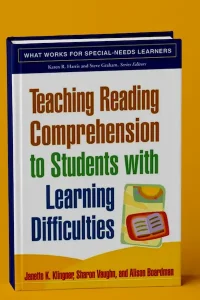Teaching Reading Comprehension to Students With learning Difficulties is designed to help undergraduate and graduate students extend their knowledge of reading instruction related to comprehension as well as to assist practicing teachers in furthering their expertise.
Teaching Reading Comprehension to Students With Learning Difficulties PDF
Teaching Reading Comprehension to Students With Learning Difficulties is a highly practical resource for the classroom, this book offers clear, research-based recommendations for helping students at all grade levels understand and learn from what they read.
Explaining the skills and strategies that good readers use to comprehend text, the authors show how to support struggling students in developing these skills.
They present a variety of effective assessment procedures, ways to enhance vocabulary instruction and teach students about different text structures, and instructional practices that promote comprehension before, during, and after reading.
Special features include discussion questions in every chapter and reproducible instructional materials and lesson plans.
Book Features
This book includes many features designed to make it readily accessible to educators.
- In each chapter, we provide background information about the research supporting the aspect of reading comprehension under discussion.
- We also describe how to carry out different instructional approaches and utilize numerous figures, graphs, and tables to illustrate our approaches.
- In selected chapters, we also offer sample lesson plans.
- Finally, at the beginning of each chapter, we list three or four study group questions designed to prompt reflection and dialogue about reading comprehension.
Book Reviews:
“Teaching Reading Comprehension” may be a rather stale title for a book on one of the most important (and, arguably, well-studied) components of education, but the content is highly enlightening and refreshing for those concerned with improving instructional practices with students with learning disabilities, as well as all other students.
Many highly effective, practical, and research-based ideas for teaching reading are provided in this well-organized book. A considerable amount of useful information will provide all teachers with many fresh ideas for enhancing their literacy program. My one criticism is that there are several (rather small, almost silly) errors that were missed by the publishers that appear to be the result of poor editing. Just the same, those errors do not subtract from the content and should (hopefully) be corrected in future editions.
The greatest benefit of this book’s approach to struggling readers is its focus on the thinking processes of the individual learner. A plethora of ideas and instructional resources are presented in a clear and concise format. As I read this inspiring, appealing book, I learned about many techniques I can’t wait to try in the classroom!
An invaluable resource for elementary, middle, and secondary teachers; reading specialists; and special educators who work with students with reading difficulties. The book educates the reader about important components of comprehension and presents evidence-based best practices for classroom instruction. For teachers working with struggling comprehenders, this text is a ‘must-have.
This book interweaves cases, theory, and research-based instructional practices in a dynamic and accessible fashion. Klingner et al. have produced a valuable guide to reading comprehension assessment and instruction with diverse learners.
I appreciate all the information provided are research based, and for the most part are practical. The book nevertheless reads like a manual, and doesn’t seem to offer much suggestions on how to make the teaching more fun and palatable for students with learning difficulties. More real-life examples would be good, as they will illustrate clearer how the tools can be applied. Definitely worth reading, but on the whole quite dull text.


